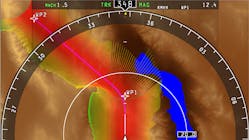Supersonic aircraft have long been known not just for their speed, but also for the sound waves they produce at supersonic speeds. To minimize or even mitigate the effects of sonic books from supersonic aircraft, NASA has been involved in a two-year-long effort, the Sonic Boom Display project (see figure), to enable pilots of such aircraft to visualize any sonic booms they might create. Using advanced algorithms and synthetic vision technology (SVT), NASA hopes to create quiet cockpits in the supersonic aircraft of the future. The results of a recent demonstration show that they are heading in the right direction.
NASA teamed with Rockwell Collins at the NASA Armstrong Flight Research Center for the recent demonstration. The project was developed to help pilots foresee how different flight plans would result in more or less sonic-boom effects. “Important to our progress in reducing the sonic boom impact over land is to have a predictive sonic boom display in supersonic aircraft cockpits that ensures our future quiet supersonic aircraft remain below acceptable noise levels,” said Brett Pauer, a subproject manager at NASA’s Armstrong Flight Research Center. “We have collaborated with avionics companies like Rockwell Collins to translate our NASA algorithms into an integrated avionics system that is tested and evaluated by pilots.”
Using advanced algorithms and synthetic vision technology, NASA’s Sonic Boom Display project provides the means to show where the flight of a supersonic aircraft will result in sonic booms on the terrain below.
The project employs NASA’s advanced sonic-boom-display avionics algorithm and a worldwide terrain database to predict where a sonic boom from an aircraft will impact the ground. “As a result of this research, we will be able to alleviate noise concerns affiliated with supersonic travel by giving pilots the ability to control boom placement away from populated areas,” explained John Borghese, vice president of Rockwell Collins’ Advanced Technology Center.


